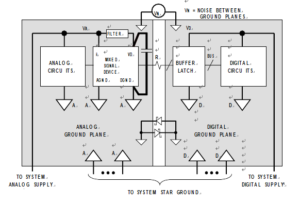Below Figure summarizes the approach previously described for Grounding Mixed-Signal Devices with Low DC in Multilayer PCB Card Cloning. The analog ground plane is not corrupted because the small digital transient currents flow in the small loop between VD, the decoupling capacitor, and DGND (shown as a heavy line).

Grounding Mixed Signal ICs with Low Internal Digital Currents Multilayer PCB Card Cloning
The mixed signal device is for all intents and purposes treated as an analog component. The noise VN between the ground planes
reduces the noise margin at the digital interface but is generally not harmful if kept less than 300 mV by using a low impedance digital ground plane all the way back to the system star ground.
However, mixed-signal devices such as sigma-delta ADCs, codecs, and DSPs with on-chip analog functions are becoming more and more digitally intensive. Along with the additional digital circuitry come larger digital currents and noise. For example, a sigma- delta ADC or DAC contains a complex digital filter which adds considerably to the digital current in the device.
The method previously discussed depends on the decoupling capacitor between VD and DGND to keep the digital transient currents and isolated in a small loop. However, if the digital currents are significant enough and have components at dc or low frequencies, the decoupling capacitor may have to be so large that it is impractical. Any digital current which flows outside the loop between VD and DGND must flow through the analog ground plane. This may degrade performance, especially in high resolution systems.
It is difficult to predict what level of digital current flowing into the analog ground plane will become unacceptable in a system. All we can do at this point is to suggest an alternative grounding method which may yield better performance.






